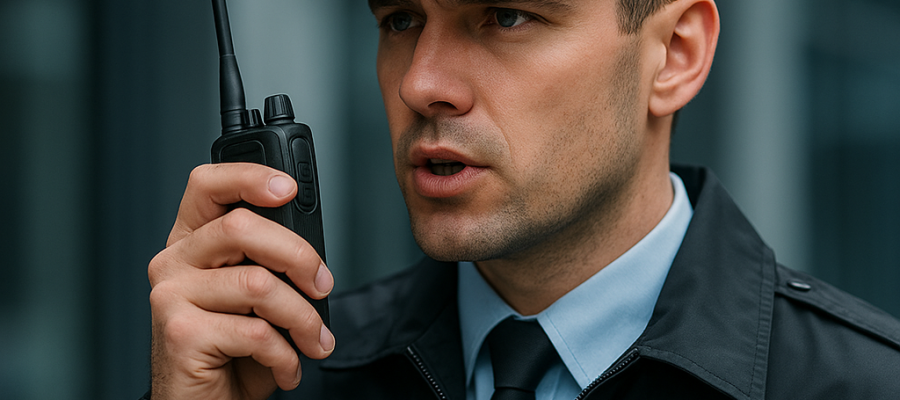Essential Radio Communication Training
A Professional Guide for the TLC Team

Mastering Radio Communication: A Professional Guide for TLC Secure Services Team Members
“Hi, this guide is here to help improve your radio communication so you can speak clearly, confidently, and professionally.”
Introduction: A Commitment to Excellence and Safety
Effective communication is the cornerstone of a successful security operation. Recently, we’ve noted some inconsistencies in our radio communications across different sites. This guide is not a response to a problem, but an investment in our collective strength. Our goal is to provide you with a clear, standardized framework for radio use. Mastering this skill will not only enhance your personal confidence and professionalism but will significantly improve the safety and security of every site you protect and every colleague you work with.
1. The ‘Why’: Your Radio is Your Lifeline
It’s easy to think of a radio as just another piece of equipment. It’s not. Your radio is the central nervous system of our entire on-site operation. It’s a lifeline that connects you to your team, to backup, and to critical support in an emergency.
Think of it this way: a single, unclear message during a developing situation—like a fire alarm, a medical emergency, or a potential breach—can lead to confusion, delayed response, and increased risk. Conversely, a clear, calm, and professional message ensures that everyone understands the situation and can act decisively.
Clear communication is not about rules for the sake of rules; it’s about ensuring that when it matters most, your message is heard, understood, and acted upon instantly.
2. The ‘How’: Professional Radio Etiquette
Professional radio use is a skill. It’s simple to learn and makes a massive difference. Follow these core principles.
The Golden Rule: One Way at a Time
A radio is not a telephone. Only one person can transmit at a time.
- PRESS and HOLD the button to talk.
- PAUSE for one second before you start speaking to ensure your first words aren’t cut off.
- RELEASE the button to listen.
Rules for Speaking
- Think Before You Speak: Know what you need to say before you press the button. A planned message is a clear message.
- Keep it Short and to the Point (Clear & Concise): Radio channels are for professional use only. State the necessary information without unnecessary words or casual chat.
- Speak Slowly and Clearly: Do not shout. Use a normal, calm tone and speak slightly slower than you would in a normal conversation. This ensures clarity, especially if the signal is weak.
Key Phrases (Pro-Words)
Using standard “pro-words” keeps communication brief and universally understood.
| Phrase | Meaning | When to Use It |
|---|---|---|
| Roger | “I have received and understood your last message.” | To confirm you heard the message. It does not mean “yes” or “I agree.” |
| Over | “I have finished speaking and am waiting for your reply.” | Use it at the end of your transmission when you expect a response. |
| Out | “I have finished speaking and do not expect a reply.” | Ends the conversation. Never say “Over and Out.” |
| Stand By | “Wait for a short period. I will get back to you.” | Use this if you are too busy to respond immediately. |
| Say Again | “Please repeat your last message.” | Use if you did not hear or understand the transmission. |
3. The NATO Phonetic Alphabet: Your Key to Clarity
Have you ever tried to spell out a name or a license plate over the phone and had someone mistake “B” for “P,” or “S” for “F”? The same confusion happens over a radio, but the consequences can be more serious. The NATO Phonetic Alphabet eliminates this risk entirely.
Use it to spell out any information that could be misheard, such as names, vehicle registrations, or location codes. Click on any entry below to hear it spoken.
Practical Example:
“Control, this is Officer Khan at the main gate. I am observing a suspicious vehicle, registration WY65 ZSU. I repeat: Whiskey Yankee Six Five Zulu Sierra Uniform. Over.”
4. Building Your Confidence
Using this formal language can feel strange or even a bit robotic at first. This is completely normal. Confidence comes with practice.
- Practice Makes Perfect: During quiet periods, practice constructing messages in your head or with a trusted colleague. Run through a few mock scenarios.
- Listen to Others: Pay close attention to how experienced officers and the control room operators communicate. You will learn the rhythm and flow of professional radio traffic.
- Don’t Be Afraid to Ask: If you are ever unsure of a message, always ask for a repeat by saying “Say again.” A professional officer prioritizes clarity over ego. It is always better to ask for clarification than to act on misunderstood information.
Conclusion: The Mark of a Professional
Mastering radio communication is a non-negotiable skill for an elite security officer. It is a direct reflection of your professionalism, your attention to detail, and your commitment to the safety of the team.
By following these guidelines, you are not just learning to use a tool—you are strengthening the entire TLC Secure Services team. Let’s continue to work together to maintain the highest standards of safety and professionalism.
